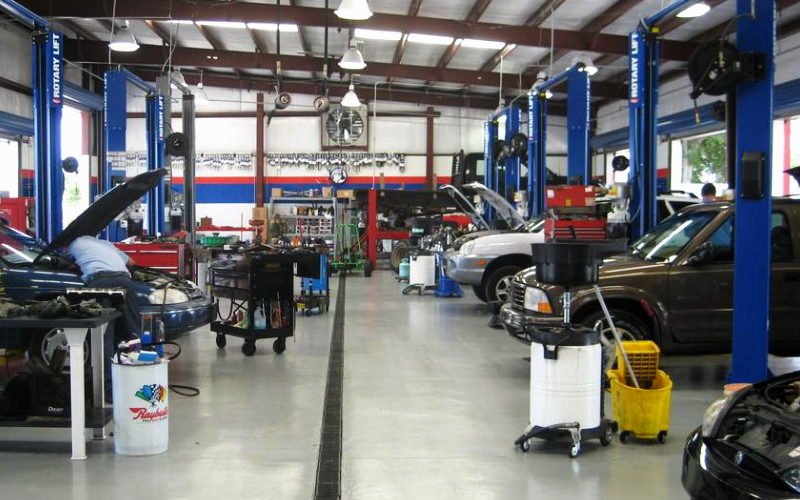The humble neighborhood mechanic has been a staple of just about every community across the US for many decades now. Indeed, it’s the case that anywhere in the world where there is a large population of cars you will also find a huge need for mechanics. That stands to reason.
We live in a very different automotive world in 2021, though. Sure, there are still many millions of internal combustion engines still on the road, millions more still rolling off the production lines…so what has changed? No one can deny the rising status of electric cars. Just about every major car producer now has at least one all-electric offering in their range, and with a lot more on the way.
As governments around the world continue to set deadlines on when automakers will have to cease production of new gasoline and diesel models, the world now increasingly looks to electric cars when looking to replace one of their old vehicles. The problem, however, is what to do about all the mechanics who have spent their entire career focused on internal combustion engines.
This is theme of today’s blog. How will an apparently under-qualified demographic of mechanics be able to function in a world where EVs are the rule and internal combustion engines the exception? Is this the end for the neighborhood mechanic?
Chicago Tribune: “People Are Freaking Out”
Back in 2017, the Chicago Tribune did a report in which they interviewed an auto mechanic called Craig Van Batenburg based in Massachusetts. Van Batenburg was 67 at the time of the interview, and already a veteran of the industry having made his start as a mechanic back in 1970 when the idea of electric cars or any other type of vehicle as the norm was something that belonged only in the realms of science fiction.
Van Batenburg said in no uncertain terms that “people are freaking out,” referring specifically to those in the auto mechanics profession. These are mechanics who, in Van Batenburg’s view are resistant to change and thus doomed to be overtaken by events in the increasingly electrifying automotive world.
People like Craig Van Batenburg are not wrong about the need for change. The same Chicago Tribune article gave figures for that time which pointed to the fact that the US auto repair industry employs some 750,000 people. That’s four times as many at the time of writing that were employed in the national coal-mining industry. All of these workers are extremely skilled, of course, but the EV changes the game dramatically.
The increasing number of electric cars on the roads presents an increasingly pressing issue for mechanics, which is that these EVs, on the whole, need so much less maintenance than your average internal combustion car. They don’t need oil changes; they have fewer moving parts; they rarely (if ever) break down. This type of work forms the “bread and butter” that helps most auto shops survive their many years in business.
Why Do EVs Threaten the Neighborhood Auto Shop?
According to the Chicago Tribune, there are something like 160,000 independent auto shops in the United States. These shops depend on the steady stream of work that comes to them from a typical car, especially cars that are not Japanese or German and therefore need more frequent attention — but even the most reliable cars need oil changes!
Below is a list of what a typical car would need as part of their regular maintenance schedule, ranging from once or twice a year, to once every 3-5 years and beyond:
- Oil and filter changes
- Air and fuel filter changes
- Transmission fluid flushing and changing
- Other fluid checking and replacing – brake fluid, coolant and others
- Replacing and repairing hoses, belts, chains, etc.
- Replacing brake pads and repairing brake rotors
- Emissions testing
- Tire rotation, inflation and replacement
- Battery health checking and replacement
- Catalytic converter and exhaust system checks and repairs
- …and many more
The typical internal combustion engine car has a huge shopping list of repairs and common maintenance jobs, all of which has given birth to the huge range of auto shops and service providers that we see all around us. Some specialize in just a small area, and why wouldn’t you when there’s so much work to go around?
The same cannot be said of the common electric car. Their maintenance schedules are nothing like as busy as those of a traditional gasoline or diesel car. What’s more, and increasing number of issues and problems with these cars are being solved not by mechanics at the auto shop but by computer technicians from hundreds or thousands of miles away in some corporate headquarters or massive IT department. Over-the-air updates are steadily moving from strictly software and infotainment issues to even solving mechanical issues like braking distances.
Let’s reflect on the typical electric car:
- No engine – so, no engine oil, ergo no oil changes
- Also, no hoses, belts, chains or gaskets to worry about
- No emissions – so, no catalytic converter, no exhaust system
- No engine – so, no cylinders, no gaskets, no fuel filters, no fuel injectors
To give you an idea on just how much sparser the maintenance schedule of an electric car is, you can take a look at that of the Chevy Bolt:
- Tire rotation: every 7,500 miles
- Cabin air filter replacement: every 22,500 miles
- Coolant flushed: every 150,000 miles
These are the main features. The remaining servicing attention will be focused entirely on the battery pack and connected systems. Issues with the car’s electronics and on-board software will nearly always be solved by over-the-air updates. Technicians might be required in some cases, but almost never as a first line of defense.
Herein Lies the Threat
Knowing all of the above, we discover the threat to the livelihoods of America’s 160,000 auto shops and their 750,000 employees. Regardless of how many of that 750,000 are full-time mechanics, there simply won’t be enough work to go around once the driving world has gone electric.
Van Batenburg also referred to the many mechanics who were resistant to change. What he was referring to were those who refused to train themselves in new technologies and methods so that they would be qualified to work on electric cars just as confidently as they are currently on gasoline and diesel cars.
Most EVs are currently only serviced by dealership technicians and mechanics as owners struggle to find other mechanics who are qualified to even work on their Nissan Leaf or other electric car. With dealerships and OEM mechanics dominating, and so many mechanics resistant to change, does the increasing dominance of the EV spell the end for the neighborhood mechanic altogether?
Other Ways that EV Maintenance is Different
It seems that unless mechanics are willing to get familiar with the systems and other workings of EVs, then they are dooming themselves to failure. So little of what they already know about gasoline and diesel cars transfers directly over to EVs.
Besides the differences we have already described above, here are some more ways in which EVs are beyond the skills of the common auto mechanic:
EV Batteries
Instead of the engine and all its many interconnected moving parts, the new heart of the modern car is the enormous and complex battery pack. The typical mechanic does know a thing or two about batteries, but the kind of batteries powering the BMW i3, the Tesla Model S and the GMC Hummer EV are nothing at all like the 12-volt lead acid batteries of yesteryear.
Where your current mechanic can trickle charge, replace, repair and perform just about any maintenance you need on a 12-volt battery, the same can’t be said for a 90kWh battery pack that essentially forms the entire underside of your car. EV batteries are based on advanced chemistry, and while they can be replaced and repaired, the ordinary mechanic would certainly need additional training in how to deal with the needs of these battery packs.
Right now, the most qualified technicians to work on EVs are those who work at the OEM dealerships. They have received special training in how to manage the specific chemistry and makeup of each OEM battery, most of which are quite different in design. From their modular structure to their cooling systems, there are huge differences. Mechanics of the future who want to continue as generalists may need to learn about several different OEM battery chemistries and cooling systems just to be able to offer battery maintenance in their neighborhood where people are driving different EVs.
Regenerative Braking
Another unique feature that started in hybrid models but has significantly evolved in electric cars is that of regenerative braking. Early EV promoters like Tesla and Nissan with their Nissan Leaf have become well-known leaders in the field of regen braking.
Mechanics are undoubtedly aware of the somewhat older system found first in hybrid models that captured energy emitted when the driver pressed on the brake pedal and transferred it as electrical energy to the car battery to help it last longer. In modern EVs, however, no brake pedal is typically involved in regenerative braking.
When you take your foot off the gas pedal now, the car typically starts to brake. On a Tesla, you were previously able to set the regenerative braking in three different settings — though that feature has now gone — through which you could choose the strength of the effect. It ranged from a mild braking effect that saved you a little stress on the brake pedal to essentially being able to bring the car to a halt safely whenever you needed it to, and without input on the brake pedal.
Why would this be of a worry to mechanics. Brakes were one of the few systems in an EV that still worked pretty much the same as for gasoline and diesel cars, making most mechanics qualified to work on them. With regenerative braking, the effect of slowing the car is achieved by reversing the electric motors and not by applying the brakes, which means a vast reduction in wear and tear on the brakes and thus yet another huge way in which we need attention from a mechanic less and less than before.
OTA Updates
There are already many people drawing the clear parallels between modern electric cars and smartphones. Beyond the obvious things like both of them being in need of regular charging-up periods, they are also subject to period updates that are sent out from the manufacturer. Smartphones and even home computers have made us all very aware of such updates. We receive a notification that a new system update has been downloaded or otherwise prepared and the system needs to restart while it installs it and updates your device.
Thanks to companies like Tesla, this is now a reality on our cars as well. “Over-the-air” (OTA) updates have created a bona fide revolution in the world of cars. Where they started as solutions merely to software and other digital issues within the car, they have proven to be far more capable than any mechanic could have possibly imagined.
OTA updates have now evolved in several ways. First of all they can be used to install all-new features onto a car. This in itself is a game-changing idea. It means that companies like Tesla are thinking of their models not as finished items but as “base models” that are a continuing work in progress. In this sense they are certainly like smartphones. Smartphones get new physical models every year or so, of course, but users who opt to retain their current model can still benefit from new updates and upgrades to their operating system and other features. The same is now true of Tesla cars. Updates don’t just benefit the newest models, but help keep all models on a more equal footing — to a point at least.
Second, OTA updates have already been used to fix things that are linked to the car’s physical performance. Since so much of the way a Tesla works is linked to digital algorithms within the car’s computerized systems, the company is able to create performance enhancements to range, braking, traction, vehicle stability, acceleration and more elements of the car via OTA updates.
From this we can clearly see that the age of calling up the mechanic to get new components installed could be coming to a close. With other major auto giants like BMW, GM, VW, Ford, Mercedes-Benz, Hyundai, Honda, Stellantis (formerly FCA), and Toyota all pursuing the OTA-update model for their future cars, it is already showing itself to be a major trend. Those mechanics that don’t retrain and become ready for this world will surely be left behind.
Deadline 2030-2040: Will Mechanics Be Able to Survive? Probably
While the US is yet to set any kind of deadline on a federal or national level with regards to stopping the sale of new gasoline and diesel cars, many individual states within the US have already committed to timeframes within 2030-2040. This is in line with what many countries in Europe and others around the world are also trying to achieve.
Will mechanics be able to retrain in time and be able to function in the ever-electrifying world? The answer is most likely yes, they will. While it’s certainly true that the number of 750,000 mechanics may well come down over the years, there will still be plenty of years of work ahead. Here are two of the main reasons that most mechanics who want to go on will be able to:
1. Training has already begun. The Washington Post, also in 2017 while the Chicago Tribune was reporting on the perceived dangers of EVs to the neighborhood mechanic, shared an interview with Bill Moss, a mechanic based in Virginia. Moss shared with the Post a number of key insights, primarily that the majority of mechanics have already been transitioning to the more digitalized auto shop practices for a long time now. Moss has already had his own team training to work on electric cars since 2017, which means that by a milestone year like 2030, his team will have at least 13 years or so of experience in working on EV matters.
Moss was quoted by the Washington Post as saying, “We already do a lot more work with a laptop than we do with a wrench anymore…” essentially pointing to the fact that computerized work and digital systems are nothing new to mechanics.
With a new generation of mechanics receiving training as we speak, it probably won’t matter that we currently have a shortage in these EV-related skills. We’ve talked about the situation in the US, but it’s no different in other countries. The Institute of the Motor Industry (IMI), based in the UK, found in 2018 that a startling 97 percent of active auto mechanics were not properly qualified to work on electric cars. Such numbers are typical everywhere.
The good news is that even in the UK where sales of new gasoline and diesel cars are set to cease in 2030, it means that even currently untrained mechanics still have 9 years to learn before EVs really start to become the biggest part of the market. Until then, while electric cars are growing their market share, they are still in a tiny minority. This brings us to the next key point.
2. Combustion engines aren’t going to disappear overnight. Even when the deadlines hit in Europe and those states that opt to stop the sale of new gasoline and diesel models, two things will still be true:
- Millions of legal gasoline and diesel cars will remain on the roads
- Many people will continue buying and selling pre-owned gasoline and diesel cars
It could be another decade or two after the deadlines are crossed that we actually see electric cars becoming the dominant force in the marketplace. While some countries like Norway have already moved to a majority-electric market, they are quite a unique case. Right now, EVs are still too expensive, and the factors of charging infrastructure and range anxiety linger enough for people not to consider making the switch to electric just yet.
All of this means that there is still likely to be plenty of work available for those “old-school” mechanics who want to keep working on combustion cars only. The time gap should be more than sufficient to allow the transition between that generation and new generation of EV-focused mechanics. That cohort of mechanics will undoubtedly be smaller, given the much-reduced maintenance that is required overall on EVs, but your neighborhood mechanic is nonetheless bound to endure on some level.
Conclusion: The EV Will Change the Mechanics, But Not End Them
It’s impossible to deny that great change is on the horizon. The fact is that independent mechanics will struggle in the face of so much dominance from the OEM technicians. With each manufacturer building their EVs in such different ways and using so much proprietary technology, what we may see in the world of independent auto shops is a kind of “reset.”
What could happen is that many mechanics will restart as very small outfits only able to challenge the OEM dealerships in small ways at first. Over time, as the techniques and technologies become more generic, more widely adopted and more widely understood, there will be a kind of auto shop renaissance. The movement will be led by intrepid automotive entrepreneurs who find ways to beat the complacent OEM mechanics at their own game. All of that is still to come, however, and at this early stage remains impossible to predict.



